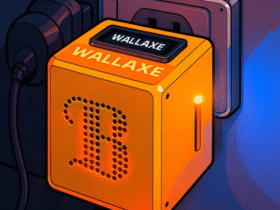For the specialist, Bitcoin has already resolved its scalability and has established itself as a store of value.
Lerner claimed to be in favor of practical solutions, which is why he was critical of CBDCs.
In the most recent edition of LABITCONF, CriptoNoticias had the opportunity to talk with the co-creator of Rootstock, Sergio Lerner, who explained that, according to his vision, Bitcoin should remain stable while innovation occurs in the upper layers.
«We Bitcoiners now believe that Bitcoin is, essentially, a store of value [reserva de valor]», stated Lerner at the beginning of the conversation. From that premise, he maintains that any advance in payments, smart contracts or decentralized finance must be built outside the base layer.
“We cannot continue touching Bitcoin because it is very expensive to reach a consensus to change it,” he noted.
Additionally, the developer talked about the concept of exhaust velocity [velocidad de escape] formulated by Vitalik Buterin, which describes the minimum functionality that a network must offer to avoid constant changes to its protocol. Applied to Bitcoin, he explained, it means provide only the minimum computation necessary so that the coins can be transferred to the secondary networks, where all the most dynamic activity of the ecosystem will be concentrated.
In other words, Sergio Lerner’s perspective can be summarized as follows: Bitcoin would have already achieved its fundamental purpose as a more secure and change-resistant store of digital value. Precisely because of that strength, The specialist suggests not modifying your base protocol further.
Rootstock as a permanent layer for Bitcoin
Asked how to define Rootstock in a simple way, the project’s co-founder explained that it is “Bitcoin’s first sidechain”, a network that allows users to move their capital to use it in faster and cheaper applications. There, blocks are confirmed every 25 seconds, commissions are pennies on the dollar, and people have access to a broad ecosystem of decentralized finance, all without parting with Bitcoin.
He also clarified that Rootstock supports the EVM standardallowing wallets like MetaMask or Enkrypt to work frictionlessly. In this way, applications originally created for Ethereum can be replicated in an environment whose native asset is anchored to the value of bitcoin (BTC).
When asked if Rootstock was a temporary or permanent solution, in the sense that they were planning to step aside in case Bitcoin smart contracts were fully developed, Lerner was blunt: “The idea of Rootstock was always that it would be a permanent layer 2 that integrates into the Bitcoin infrastructure.”
For the developer, what is desirable is that “if we want to have a payment network or smart contracts, we have to do it in other layers.”
BitVMX and the path to fully decentralized bridges
Another topic he addressed was the future of the bridges between Bitcoin and Rootstock. For years, some bitcoiners criticized the federated model — a group of companies that helped move money to the sidechain — as too centralized. Lerner admitted that those criticisms made sense, but clarified that this structure was never the end goal.
“That was a temporary solution until we could develop fully decentralized bridges, and today we are very close to achieving that,” he explained.
He also explained that the speed and interactivity offered by Rootstock and its rollups, capable of processing transactions in hundreds of milliseconds, is something that Bitcoin alone will never be able to provide.
To ensure that funds move in a completely decentralized way towards these faster layers, BitVMX emerged, an open source platform developed by Rootstock Labs and Fairgate Labs, which powers the minimum computing capacity necessary to execute contracts on Bitcoin.
«We do not think that end-user applications will run on Bitcoin, because they will always prefer low costs and speed, something that the base layer cannot sustain over time. BitVMX serves to move BTC in a decentralized way to Rootstock,” he said.
The first major development using BitVMX is the Union bridge, implemented with a 1-of-N security model; That is to say, even if there are hundreds or thousands of participants guarding the bridge, it is enough for only one to be honest and always connected so that no one can steal or freeze user funds.


According to Lerner, BitVMX is up and running on Alphanet today. He testnet will arrive in about six weeks and the beta in mainnet within two or three months. “We are about to achieve something that we started dreaming about a year and a half ago,” the specialist commented enthusiastically.
Rootstock adoption and the effect of stablecoins
In terms of geographic adoption, Lerner pointed out that Rootstock has always had a solid community in Argentinaits country of origin, and which has also experienced significant growth in the rest of Latin America and Africa. Although it does not track usage metrics in detail, it ensures that the region maintains a particularly active ecosystem.
Then, he took the opportunity to leave a message to those who today use Tron to move stablecoins: “I would like Argentines and Latin Americans, instead of using Tron, to opt for Rootstock, where Tether is also present and which has the security of 85% of the Bitcoin miners who participate in Rootstock.”
On the other hand, in the face of the recent proliferation of centralized stable currencies – including those issued by Latin American companies – the businessman also firmly defended an alternative model: stablecoins collateralized only in Bitcoin.
He recalled that this was the spirit with which Rootstock was born and that the Money on Chain protocol – a DeFi platform native to the sidechain – has been offering exactly that model for years, without banks or reserves in fiat dollars involved.
“For me, that is the endgame: a decentralized dollar because its collateral is Bitcoin,” he noted. Although he recognizes that tether (USDT) and usdc coin (USDC) will continue to exist due to his entrepreneurial drive, his long-term vision is for digital fiat currencies to depend only on BTC reserves and not on bank accounts vulnerable to confiscation.
Criticism of CBDCs and optimism for the price of bitcoin
Lerner also shared a strong position on central bank digital currencies (CBDCs), especially in light of surveillance experiences in countries like China. «I am very afraid of CBDCs. People have to live in fear because anything can affect their ability to travel and shop. “That is permanent surveillance,” he said bluntly.
It is worth noting that, for many specialists, projects of this type – among which is the digital euro – represent a strong blow to the freedom of users.
Then, he lamented that the incentive for governments to build a system that works like cash, private and without monitoring, is “almost zero.”
Finally, when asked if bitcoin is already in a bearish period or if a new all-time high may appear soon, Sergio Lerner avoided the future, but made his long-term position clear: he fully trusts in the programmed scarcity of Bitcoin.
“I know that it is an asset that has a limited issuance… and if it is scarce, in the long run it will always increase in value,” he explained. For him, volatility is not a problem.






Leave a Reply